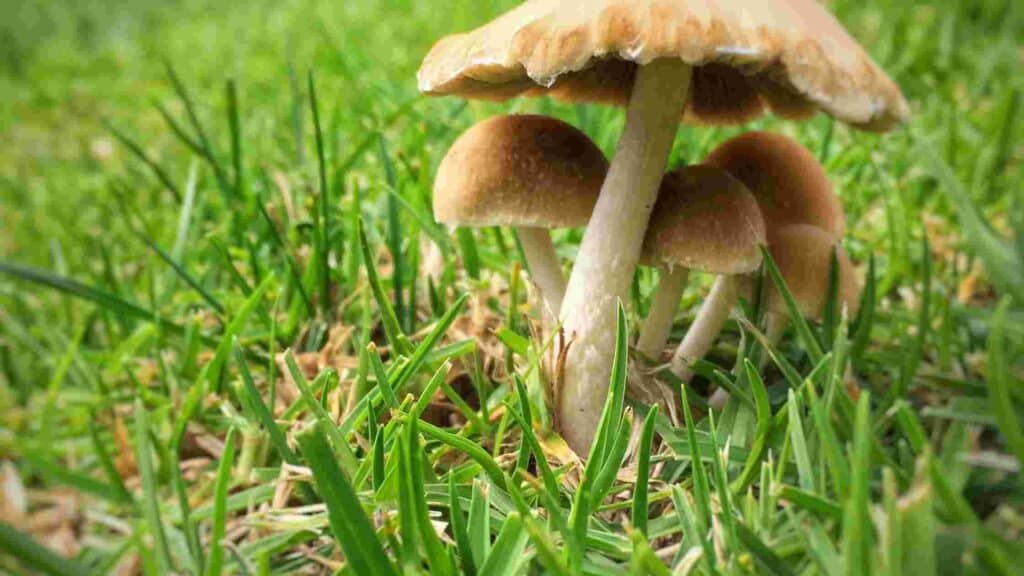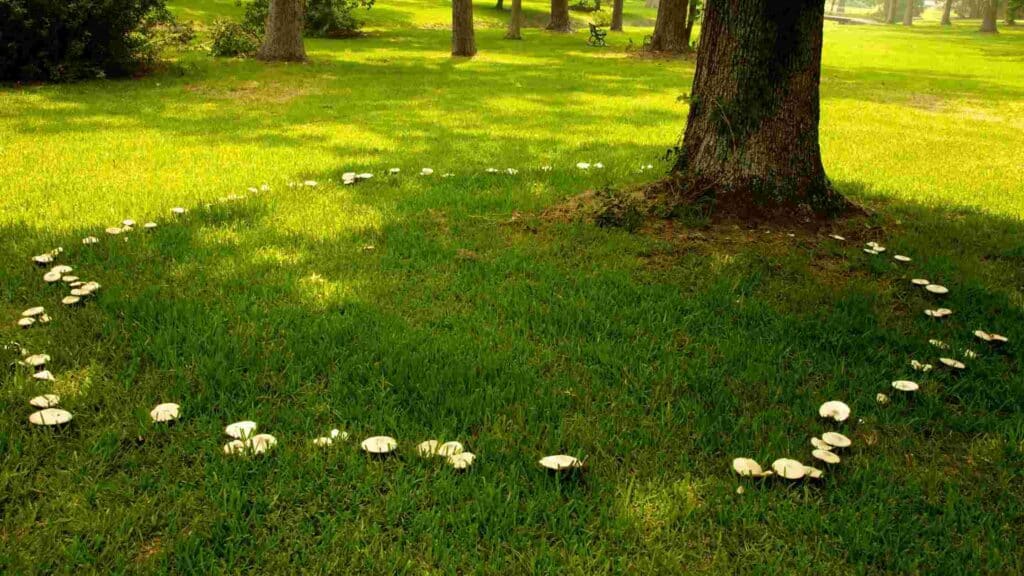If you’ve ever wondered how to get rid of backyard mushrooms that keep popping up, you’re in the right place. We’ve got all the tips and tricks you need to reclaim your lawn and keep it looking top-notch.
So, let’s roll up our sleeves and dive into some backyard mushroom management!
How To Get Rid Of Backyard Mushrooms
Now that we’ve identified the mushrooms, let’s equip ourselves with an effective plan to get rid of them. By following these straightforward steps, you’ll create a mushroom-free backyard in no time.
1. Apply Soapy Water
Grab about 2 tablespoons of dish soap and mix it with a generous 2 gallons of water.
Equip yourself with a shovel and start poking some holes around the mushroom hotspots. Once you’ve got the holes lined up, fill them with the soapy water mixture.
You may also be interested in finding out how to get rid of mushrooms in mulch.
2. Pluck The Mushrooms
The key is to spot these lawn mushrooms early before they have a chance to spread their spores and wreak havoc. So, as soon as you notice any new mushrooms, swoop in and pluck them out of the ground.
Discard Them Properly
Proper disposal is crucial to prevent further mushroom growth. Instead of tossing them into the compost pile, get a plastic bag, place the mushrooms in, and tie it up tightly.
Then, make sure to throw that bag right into the trashcan. That way, those spores won’t stand a chance of spreading in your backyard.
Use Nitrogen Fertilizer
Use nitrogen fertilizer to speed up the decomposition of that organic matter.
You’ll need about 1 pound of nitrogen for every 1000 square feet of your backyard (check out the lawn fertilizer calculator). But remember to steer clear of slow-release or water-soluble nitrogen fertilize.
For the best results, don’t make this a one-time affair. Do it annually to keep those mushrooms at bay.
Why Do I Suddenly Have So Many Mushrooms In My Yard?

Let’s uncover the reason behind the growth of these fungi. Mushrooms signal a healthy ecosystem in your lawn.
But when you have kids or furry friends like dogs around, they can become a bit of a concern (check out the article: Are backyard mushrooms poisonous to dogs?).
Not to mention, they’re just not the most aesthetically pleasing sight to behold. So, what’s causing these mushy invaders to pop up?
1. Organic Matter
Organic matter plays a vital role in mushroom growth. These fungi thrive by munching on the remains of old stumps, tree roots, or even buried timber.
So, if you’ve got any of these lurking around, the mushrooms are bound to take notice and make a comeback.
2. Moisture
Ever noticed mushrooms doing a surprise appearance after a night of rain?
Well, moisture is the ingredient that prompts their swift arrival in your backyard. When the ground is wet, it supports the growth of these fungi.
3. Shade
Not all mushrooms are fans of the shade, but some sure are. When you combine the perfect blend of moisture, organic matter, and a hint of shade, you’ve got yourself a mushroom wonderland in your backyard.
How Do I Stop Mushrooms From Growing In My Backyard?
Now that we’ve cleared the mushrooms from our backyard, let’s talk about keeping them from coming back.
1. Reduce The Shade
We’re cutting down on shade because fungi love shady areas. Time to let the sunshine in!
Cut close to the trunk, right beyond the bark ridge, without leaving any stubs. Angling downward ensures rainwater won’t pool up and cause rot.
Keep your trees healthy and fungus-free by trimming out any dead or diseased branches. They won’t stand a chance against vigilant pruning!
Dethatch the lawn to give mushrooms even fewer hiding spots. Use a convex rake for manual dethatching or rent a power rake from your local hardware store.
For cool-season grasses, dethatch between late summer and early fall. Warm-season grasses prefer the end of spring for dethatching.
2. Fix The Drainage
Remember, mushrooms love damp environments, so it’s time to address any drainage issues in your backyard.
- Tame the Storm Waters: After a heavy storm, if water is pooling up, rain barrels are a good solution (here are the best rain barrels). Place them beneath waterspouts, and they’ll collect all that extra water during the storm, keeping your yard dry and mushroom-free.
- Water Flow Solutions: If water’s flowing down a slope and causing trouble, let’s redirect it. Build up the soil in a way that steers that excess water to a more suitable spot, like a garden or a pond.
- Fix Stagnation: Introduce an underground drain system to disperse water and prevent any future backyard swamps and drainage problems.
3. Ensure The Backyard Has Well Drained Soil
Make sure that the soil is top-notch, so water doesn’t stick around.
If your yard has a clay base that tends to hold water, mix in some sand or other well-draining material. That way, water won’t linger, and mushrooms won’t be able to find a spot to grow.
When watering your backyard, do it in the morning so the sun can evaporate any excess water before those mushrooms can breed.
4. Get Rid Of Decaying Matter
It’s time to get rid of any decaying elements or tempting organic matter that mushrooms can feed off.
Remove any small branches or decomposing wood chips that might attract those mushrooms.
Getting rid of tree stumps can also be beneficial (here’s how to get rid of tree stumps).
After mowing your lawn, don’t forget to rake up those grass clippings. A grass catcher on your mower works wonders too.
If you’ve got pets, make sure to clean up after them as soon as possible. Their waste is something the mushrooms like to feed off.
5. Aerate The Lawn
Time to give your backyard some fresh air with a little aeration action!
Trapped moisture is stomping ground for lawn mushrooms. Grab an aerator and give your yard some breathing space by pulling out plugs of earth (find out the best lawn aerator machine in the market) .
How To Get Rid Of Fairy Rings In Lawn

These fairy rings of mushrooms grow in the grass and are easy to identify.
1. Find Out The Depth Of The Fairy Rings
Grab your shovels and start digging around those mushrooms. Look out for a white, fibrous material in the soil – that’s the fungal mat. If it’s thick, we’ll need a different plan.
2. Fairy Ring Removal
If the fungal mat is less than 3 inches thick, you can use the lawn aerator. Aerate the area, starting two feet outside the ring and making your way inward. Digging deeper, remove those mushrooms and the surrounding soil.
Figure out why these rings have formed. Keep an eye out for any rotten wood or drainage blockers – those are the ones you want to eliminate!
3. Discard The Mushrooms And Soil
Not only the mushrooms but the soil nearby needs to go into the garbage bag.
Toss everything you dug up into a large garbage bag and tie it up nice and tight so that the spores don’t’ spread.
4. Refresh The Backyard
We’ve cleared the fairy rings, but now we’re left with a not-so-pretty hole in our backyard. Time to fix that up!
When you fill the hole back up, avoid immature compost as it might bring back unwanted mushrooms. Opt for mature compost – sterilized and ready to go! If you’ve got heavy clay soil, sprinkle some sand in for better drainage.
Your grass will bounce back, but it takes a bit of time. For those who want instant results, fresh sod or some grass seeds can work wonders.
FAQs
1. How do you kill mushrooms without killing grass?
Killing mushrooms without harming the grass requires manual removal and improving lawn drainage to discourage their growth. Avoid using chemicals that could damage the grass and focus on natural methods to maintain a healthy lawn.
2. What are the stops for killing mushrooms with baking soda?
To use baking soda for killing mushrooms, simply sprinkle it directly on the mushrooms. While not a guaranteed solution, it can help control their growth and reduce their presence in your lawn or garden.
3. What kills mushroom spores?
Fungicides are effective in killing mushroom spores and preventing their spread. Using a fungicide specifically designed to target mushrooms can be an efficient way to manage their growth and keep your outdoor space fungus-free.
4. What is the best lawn mushroom killer?
The best lawn mushroom killer is a fungicide containing active ingredients like chlorothalonil or propiconazole. These substances are formulated to effectively eliminate mushrooms while keeping your lawn and plants safe.
5. Is there a fungicide for mushrooms?
Yes, there are fungicides available that specifically target mushrooms. These fungicides are designed to control mushroom growth and prevent them from spreading in your lawn or garden. Always follow the instructions and use fungicides responsibly to ensure a healthy and beautiful outdoor space
Conclusion: How To Get Rid Of Backyard Mushrooms
And there you have it. Hope this article has answered some questions on how to get rid of backyard mushrooms. It’s all about being proactive.
Removing mushrooms and fairy rings is just the beginning. Stay ahead of the game with our preventive measures, and those mushrooms won’t dare to show their caps!
Mushrooms can be a healthy addition to your backyard, but we want it to look top-notch. Plus, if you’ve got kids or dogs around, let’s keep things safe and worry-free (also check out: is mulch safe for dogs?).
Once you’ve removed the mushrooms, make sure to take those extra steps to keep them from making a comeback.
So, take charge of your backyard kingdom, keep those mushrooms in check, and revel in your fungi-free oasis. Happy gardening and enjoy your backyard adventures to the fullest!
